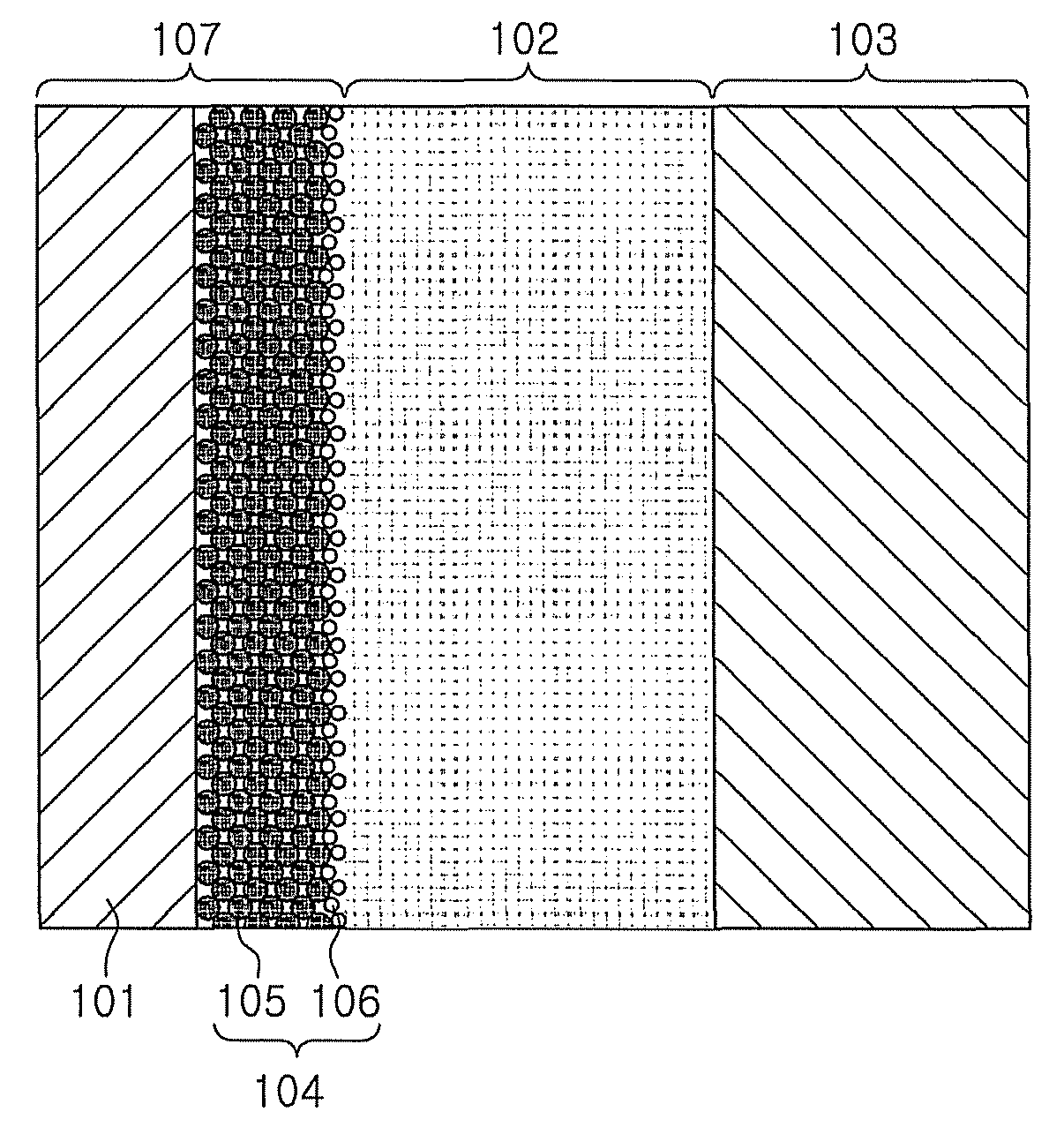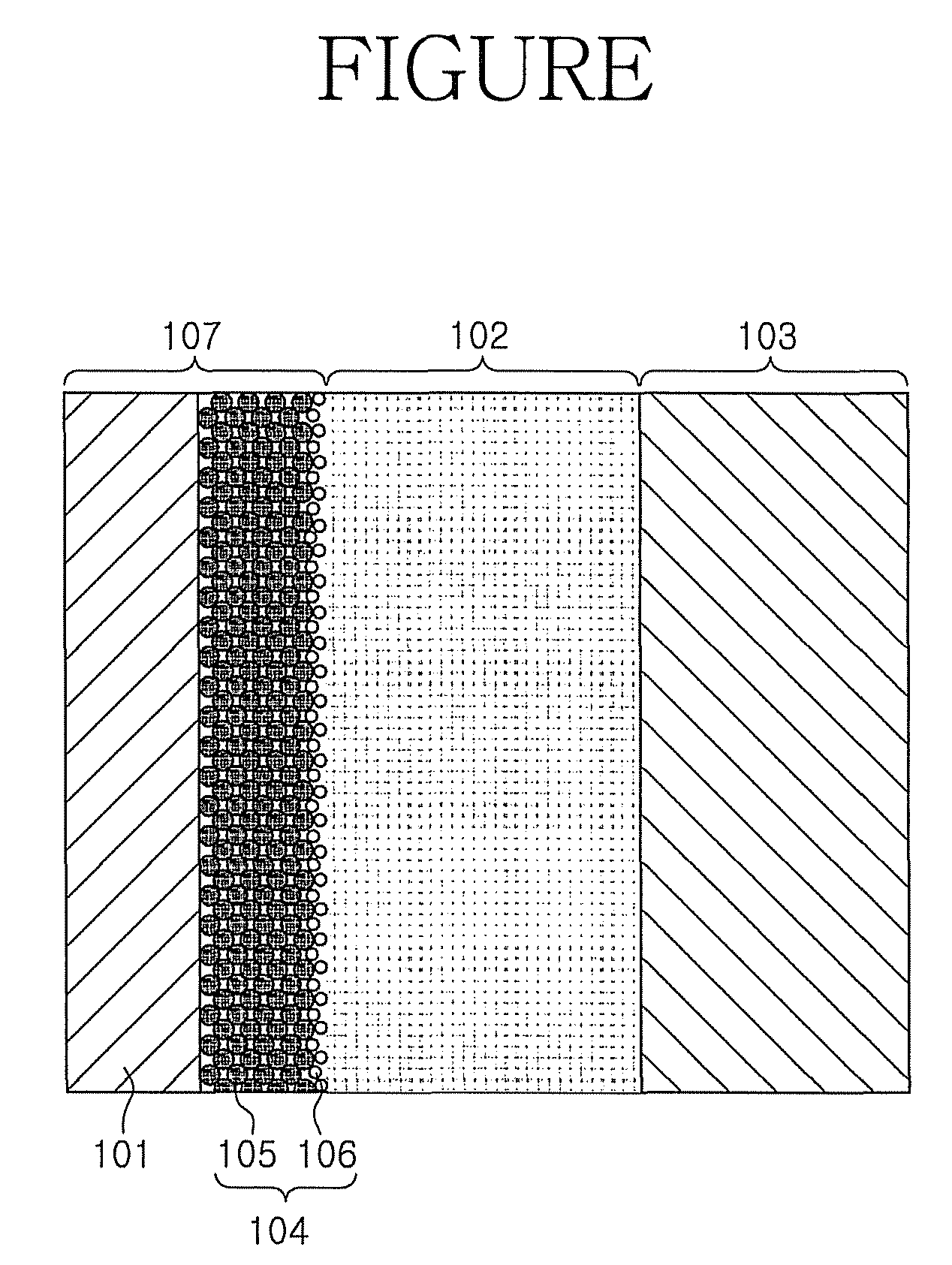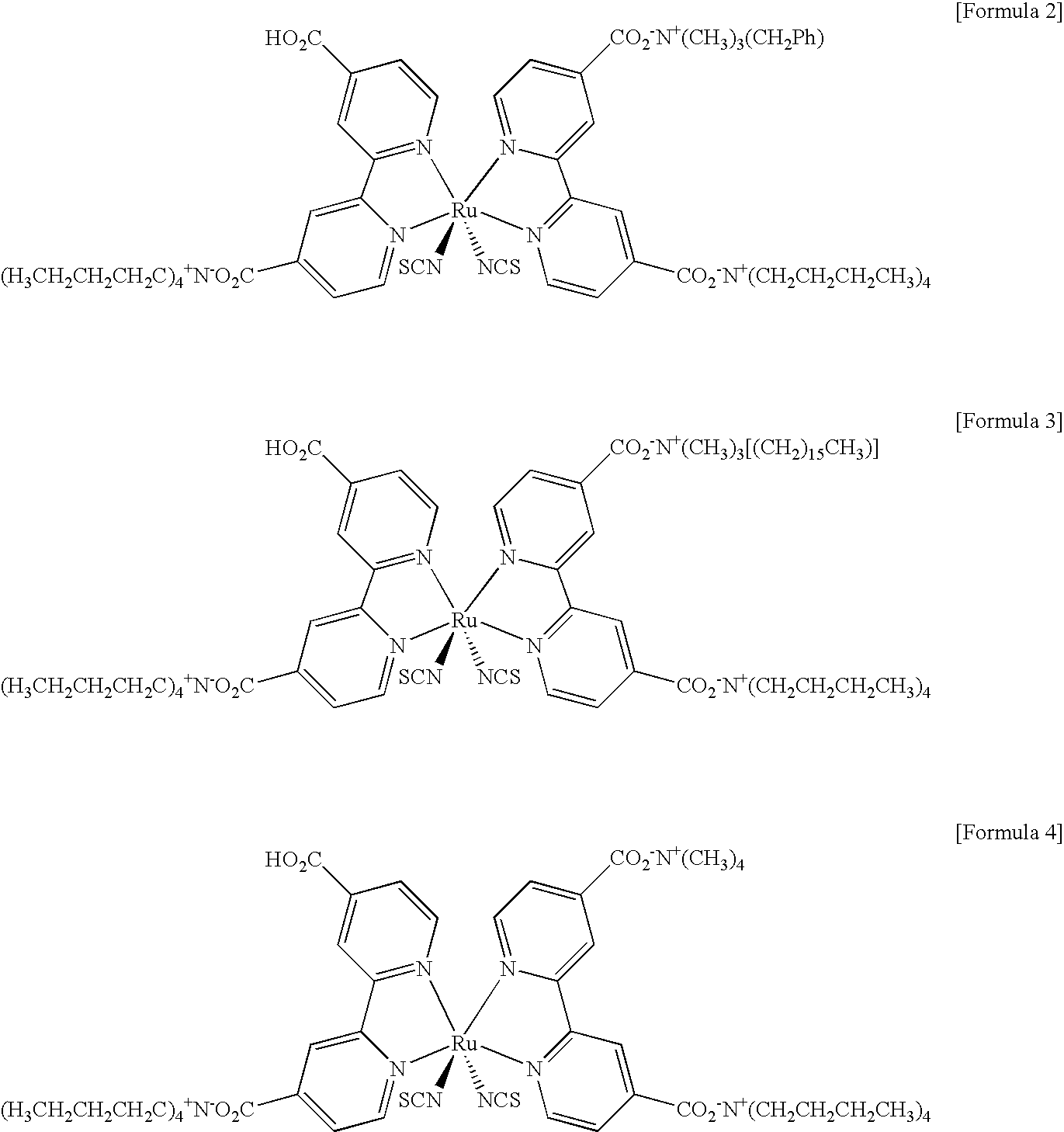Dye for photoelectric device and photoelectric device comprising the dye
a photoelectric device and dye technology, applied in the direction of pv power plants, electrolytic capacitors, ruthenium organic compounds, etc., can solve the problems of difficult to improve energy conversion efficiency and hard to put to them to practicable use, and achieve the effect of improving light absorption efficiency and high photosensitivity to sunligh
- Summary
- Abstract
- Description
- Claims
- Application Information
AI Technical Summary
Benefits of technology
Problems solved by technology
Method used
Image
Examples
preparation example 1
[0050]12.55 mg of benzyltrimethylammonium hydroxide solution (TCI CO., Ltd., 40% by weight in methanol, 0.03 mmol) was poured into a 250-ml round shaped flask having a magnetic bar put therein at room temperature and diluted with 20 mL of methanol. Next, 35.64 mg (0.03 mmol) of RuL′2(NCS)2(Bu4N)2 dye (where L′ is 2,2′-bipyridyl-4,4′-dicarboxylic acid and Bu is n-butyl) (N719 dye, Solaronix) was added to the flask, and the mixture was stirred and allowed to react for 2 hours. Then, the solvent was removed from the dye solution of N3(TBA)2(BzTMA)1 (where N3 represents cis-bis-isothiocyanato-bis(4,4-dicarboxylic acid-2,2-bipyridine)Ruthenium(II), TBA is tetrabutylammonium and BzTMA is benzyltrimethylammonium) represented by Formula 2 obtained above with a rotary evaporator. Subsequently, N3(TBA)2(BzTMA)1 was dissolved in 100 mL of a mixed solvent (10% acetonitrile and 90% tertiary-butanol, by volume) and stirred by using the magnetic bar at 650 rpm for 10 hours, to thereby obtain a dye...
preparation example 2
[0052]36.18 mg of hexadecyltrimethylammonium hydroxide (TCI Co., Ltd., 25% by weight in methanol, 0.03 mmol) was poured into a 250-ml round shape flask having a magnetic bar put therein at room temperature and diluted with 20 mL of methanol. Next, 35.64 mg (0.03 mmol) of RuL′2(NCS)2(Bu4N)2 dye (where L′ is 2,2′-bipyridyl-4,4′-dicarboxylic acid and Bu is n-butyl) (N719 dye, Solaronix) was added to the flask, and the mixture was stirred and allowed to react for 2 hours. Then, the solvent was removed from the dye solution of N3(TBA)2(HDTMA)1 (where N3 represents cis-bis-isothiocyanato-bis(4,4-dicarboxylic acid-2,2-bipyridine)Ruthenium(H), TBA is tetrabutylammonium and HDTMA is hexadecyltrimethylammonium) represented by Formula 3 obtained above with a rotary evaporator. Subsequently, N3(TBA)2(HDTMA)1 was dissolved in 100 mL of a mixed solvent (10% acetonitrile and 90% tertiary-butanol by volume) and stirred by using the magntic bar at 650 rpm for 10 hours, to thereby obtain a dye soluti...
preparation example 3
[0054]5.5 mg of tetramethylammonium hydroxide pentahydrate (Sigma-Aldrich Co., 0.03 mmol) was poured into a 250-ml round shape flask having a magnetic bar put therein at room temperature and dissolved in 20 mL of methanol. Next, 35.64 mg (0.03 mmol) of RuL′2(NCS)2(Bu4N)2 dye (where L′ is 2,2′-bipyridyl-4,4′-dicarboxylic acid and Bu is n-butyl)(N719 dye, Solaronix) was added to the flask, and the mixture was stirred and reacted for 2 hours. Then, the solvent was removed from the dye solution of N3(TBA)2(TMA)1(where N3 represents cis-bis-isothiocyanato-pentahydrate-bis(4,4-dicarboxylic acid-2,2-bipyridine)Ruthenium(II), TBA is tetrabutylammonium and TMA is tetramethylammonium) represented by Formula 4 obtained above with a rotary evaporator. Subsequently, N3(TBA)2(TMA)1 was dissolved in 100 mL of a mixed solvent (10% acetonitrile and 90% tertiary-butanol by volume) and stirred by using the magnetic bar at 650 rpm for 10 hours, to thereby obtain a dye solution.
[0055]1H NMR (CD3OD) δ(pp...
PUM
 Login to View More
Login to View More Abstract
Description
Claims
Application Information
 Login to View More
Login to View More - R&D
- Intellectual Property
- Life Sciences
- Materials
- Tech Scout
- Unparalleled Data Quality
- Higher Quality Content
- 60% Fewer Hallucinations
Browse by: Latest US Patents, China's latest patents, Technical Efficacy Thesaurus, Application Domain, Technology Topic, Popular Technical Reports.
© 2025 PatSnap. All rights reserved.Legal|Privacy policy|Modern Slavery Act Transparency Statement|Sitemap|About US| Contact US: help@patsnap.com



